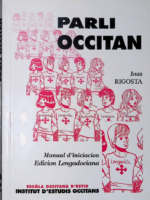| book-author | |
|---|---|
| format |
Mirèlha (Occitan Provençau)
0,00 €
Customer Reviews
There are no reviews yet.

Per toti es publicacions
Pes libres en format papèr
En lengua occitana
Tòn equipa ath tòn servici
In 1209 Simon of Montfort led a war against the Cathars of Languedoc after Pope Innocent III preached a crusade condemning them as heretics. The suppression of heresy became a pretext for a vicious war that remains largely unstudied as a military conflict. Laurence Marvin here examines the Albigensian Crusade as military and political history rather than religious history, and traces these dimensions of the conflict through to Montfort’s death in 1218. He shows how Montfort experienced military success in spite of a hostile populace, impossible military targets, armies that dissolved every forty days, and a pope who often failed to support the crusade morally or financially. He also discusses the supposed brutality of the war, why the inhabitants were for so long unsuccessful at defending themselves against it, and its impact on Occitania. This original account will appeal to scholars of medieval France, the Crusades, and medieval military history.
LAURENCE W. MARVIN is Associate Professor of History at the Evans School of Humanities, Berry College, Georgia.
This major reference work is the fourth volume in the series “Arthurian Literature in the Middle Ages”. Its intention is to update the French and Occitan chapters in R.S. Loomis’ “Arthurian Literature in the Middle Ages: A Collaborative History” (Oxford, 1959) and to provide a volume which will serve the needs of students and scholars of Arthurian literature. The principal focus is the production, dissemination and evolution of Arthurian material in French and Occitan from the twelfth to the fifteenth century. Beginning with a substantial overview of Arthurian manuscripts, the volume covers writing in both verse (Wace, the Tristan legend, Chretien de Troyes and the Grail Continuations, Marie de France and the anonymous lays, the lesser known romances) and prose (the Vulgate Cycle, the prose Tristan, the Post-Vulgate Roman du Graal, etc.).
Manual simple e eficaç per debutar un aprendissatge de l’occitan (var. lengadocian).
Joan Rigosta (en francés Jean Rigouste, Senalhac del Causse, 25 de novembre de 1938) es un pedagòg e lingüista occitan especializat en toponimia. Foguèt ensenhaire de letras als licèus d’Agen, de Merinhac e de Brageirac. Trabalhèt tanben a l’IUFM d’Aquitània e a l’Universitat de Bordèu III.
De A autant d’argent que de pesolhs à Virar coma un baciu fagord, ce sont plus de 1000 expressions et dictons occitans, enracinés au plus profond de notre quotidien, qui sont réunis et expliqués dans cet ouvrage. A leur source, l’observation et l’imagination pour les unes : Aimable coma una mosca d’ase ; Aver d’argent coma un chin de nièras ; Aver un cuol coma un amolaire ; Cargat coma un muol; Curios coma un pet ; Dormir coma una missara. la musicalité et la rime qui facilitent la mémorisation pour les autres : Al mes d’abriu, Io cocut canta, mort o viu ; Auba roja, vent o ploja ; Cada topin troba sa cabucèla ; Es lo matin que la jornada se pèrd o se ganha ; Grèc, pluèja al bec ; La raça raceja. Tous ont été choisis par l’auteur à partir d’enquêtes et de lectures personnelles.
Some of medieval culture’s most arresting images and stories inextricably associate love and death. Thus the troubadour Jaufre Rudel dies in the arms of the countess of Tripoli, having loved her from afar without ever having seen her. Or in Marie de France’s Chevrefoil, Tristan and Iseult’s fatal love is hauntingly symbolized by the fatally entwined honeysuckle and hazel. And who could forget the ethereal spectacle of the Damoisele of Escalot’s body carried to Camelot on a supernatural funerary boat with a letter on her breast explaining how her unrequited love for Lancelot killed her? Medieval literature is fascinated with the idea that love may be a fatal affliction. Indeed, it is frequently suggested that true love requires sacrifice, that you must be ready to die for, from, and in love. Love, in other words, is represented, sometimes explicitly, as a form of martyrdom, a notion that is repeatedly reinforced by courtly literature’s borrowing of religious vocabulary and imagery. The paradigm of the martyr to love has of course remained compelling in the early modern and modern period.
This book seeks to explore what is at stake in medieval literature’s preoccupation with love’s martyrdom. Informed by modern theoretical approaches, particularly Lacanian psychoanalysis and Jacques Derrida’s work on ethics, it offers new readings of a wide range of French and Occitan courtly texts from the twelfth and thirteenth centuries, and argues that a new secular ethics of desire emerges from courtly literature because of its fascination with death. This book also examines the interplay between lyric and romance in courtly literary culture and shows how courtly literature’s predilection for sacrificial desire imposes a repressive sex-gender system that may then be subverted by fictional women and queers who either fail to die on cue, or who die in troublesome and disruptive ways.
La langue d’oc ou occitan représente, à coté du catalan, du français, du francoprovencal, du castillan, [.] une des grandes langues romanes ou néo-latines qui se sont développées a partir d’une symbiose entre le latin populaire.
Pierre Bec ei professeur à l’Université de Poitiers, ancien Président de l’Institut d’Etudes Occitanes, ancien Directeur du Centre d’Etudes Supérieures de Civilisation Médiévale.

Be the first to review “Mirèlha (Occitan Provençau)”
You must be logged in to post a review.